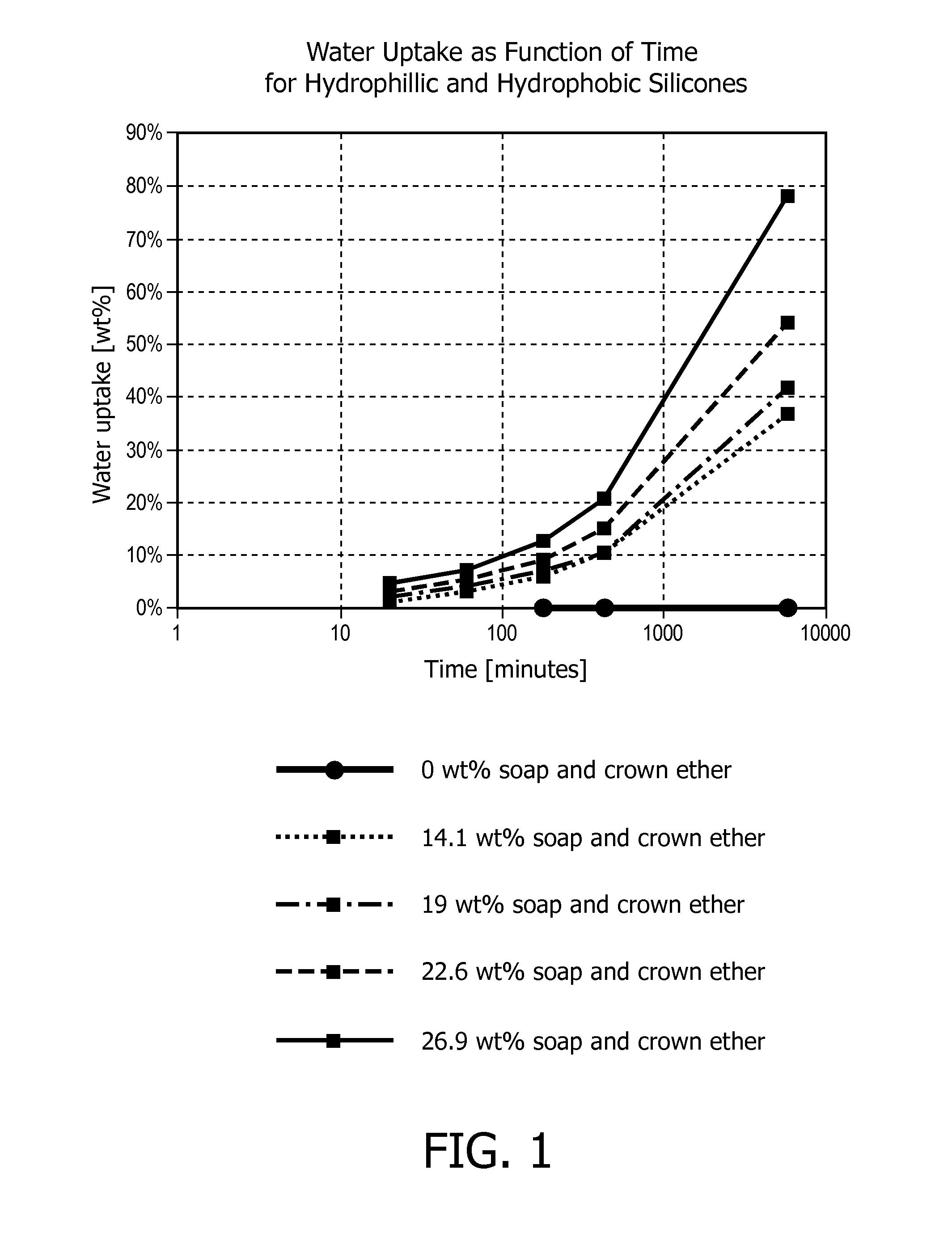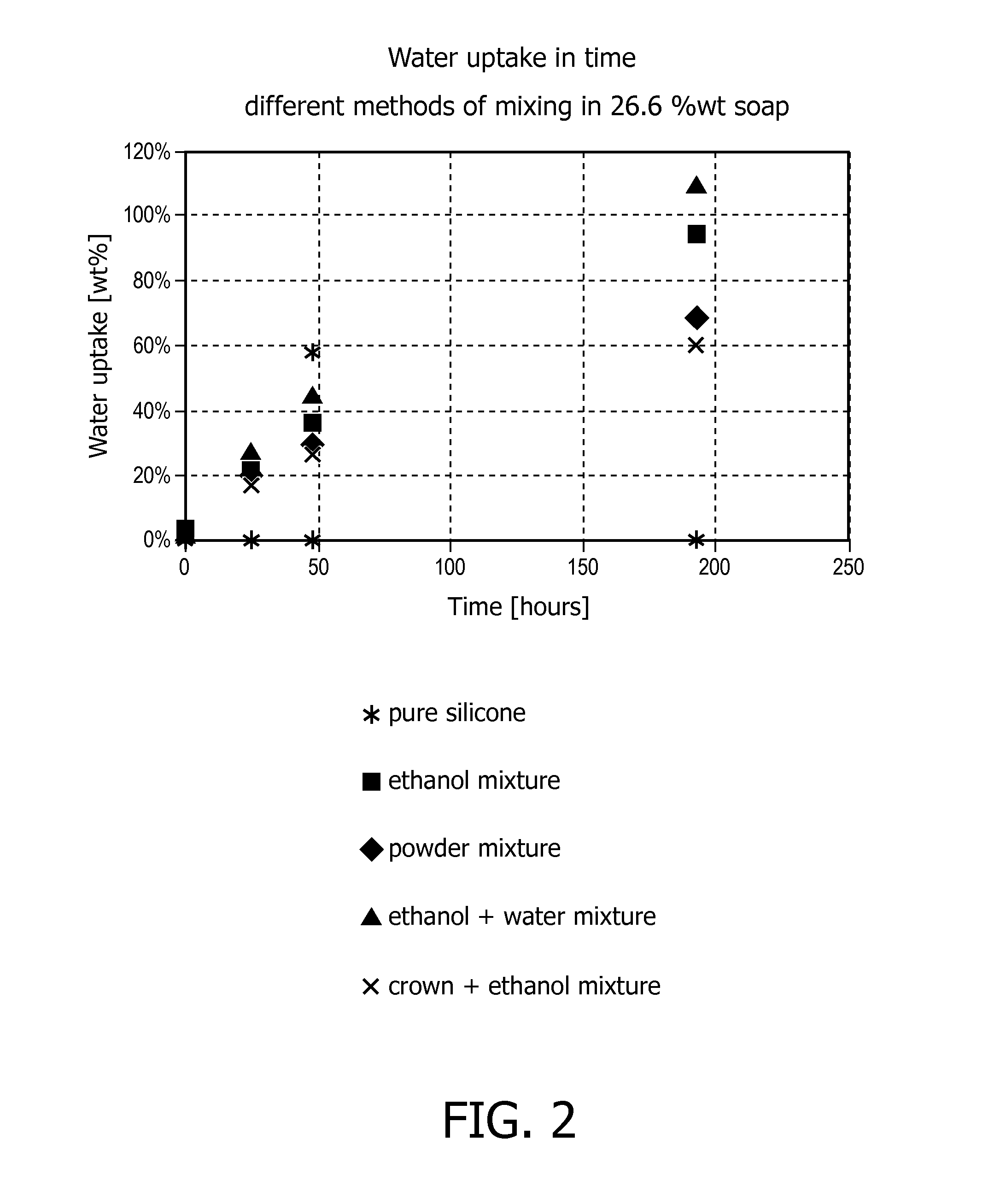Medical and non-medical devices made from hydrophilic rubber materials
a technology of hydrophilic rubber and medical devices, applied in the field of wide range of medical devices, can solve the problems of increasing the risk of repeated bleeding, reducing the ease of removal, and the uncomfortable feeling of ear head sets after a limited period of time, and achieves improved long-term stability, comfortable head sets, and strong fixed head sets
- Summary
- Abstract
- Description
- Claims
- Application Information
AI Technical Summary
Benefits of technology
Problems solved by technology
Method used
Image
Examples
example 1
[0157]The commercial silicone elastomer Elastosil LR 3004 / 40 (Wacker Silicones, Germany) was used as silicone precursor material. The silicone precursor material is a two component system that was mixed in a 1:1 weight ratio of two components A and B. The A component consists of a silicone pre-polymer bearing reactive vinyl groups and a platinum catalyst. The B component consists of a silicone pre-polymer bearing reactive vinyl groups and a pre-polymer bearing Si—H groups.
[0158]The sodium C12-14 alkenyl sulfonate commercially available from The Chemistry Store.com (Cayce, S.C., United States) was first mixed with the A component of the silicone precursor material. This mixing process is generally energy-demanding as the two components are viscous and do not mix well. Heating to 120° C. may therefore be needed.
[0159]To facilitate mixing of the commercial sodium C12-14 alkenyl sulfonate with the silicone precursor A component, a crown ether (15-crown-5) was used (10% w / w with respect ...
example 2
[0167]The commercial silicone elastomer Elastosil LR 3004 / 40 (Wacker Silicones, Germany) was used as silicone precursor material. The silicone precursor material is a two component system that was mixed in a 1:1 weight ratio of two components A and B. The A component consists of a silicone pre-polymer bearing reactive vinyl groups and a platinum catalyst. The B component consists of a silicone pre-polymer bearing reactive vinyl groups and a pre-polymer bearing Si—H groups.
[0168]The sodium alpha-olefin sulfonate RCH═CH(CH2)nSO3Na (n=12-14) commercially available from The Chemistry Store.com (Cayce, S.C., United States) with a particle size above 400 μm was first mixed with the A component of the silicone precursor material. This mixing process is generally energy-demanding as the two components are viscous and do not mix well. Heating to 120° C. may therefore be needed.
[0169]To facilitate mixing of the commercial sodium alpha-olefin sulfonate with the silicone precursor A component, ...
example 3
[0172]In a further example the commercial silicone elastomer Elastosil LR 3004 / 40 (Wacker Silicones, Germany) was used as silicone precursor material. The silicone precursor material is a two component system that was mixed in a 1:1 weight ratio of two components A and B. The A component consists of a silicone pre-polymer bearing reactive vinyl groups and a platinum catalyst. The B component consists of a silicone pre-polymer bearing reactive vinyl groups and a pre-polymer bearing Si—H groups.
[0173]A commercial sodium alpha-olefin sulfonate RCH═CH(CH2)nSO3Na (n=12-14) from Stepan Company (Northfield, Ill., United States) was used. This very fine powder (particle sizes below 400 μm) was mixed with the A component of the silicone precursor material by speed mixing. More specifically, commercial sodium alpha-olefin sulfonate (12 g) was mixed with silicone precursor A component (19 g). Then silicone precursor B component (26.1 g) was added and the obtained composition was mixed. The res...
PUM
| Property | Measurement | Unit |
|---|---|---|
| density | aaaaa | aaaaa |
| molar ratio | aaaaa | aaaaa |
| molar ratio | aaaaa | aaaaa |
Abstract
Description
Claims
Application Information
 Login to View More
Login to View More - R&D
- Intellectual Property
- Life Sciences
- Materials
- Tech Scout
- Unparalleled Data Quality
- Higher Quality Content
- 60% Fewer Hallucinations
Browse by: Latest US Patents, China's latest patents, Technical Efficacy Thesaurus, Application Domain, Technology Topic, Popular Technical Reports.
© 2025 PatSnap. All rights reserved.Legal|Privacy policy|Modern Slavery Act Transparency Statement|Sitemap|About US| Contact US: help@patsnap.com



